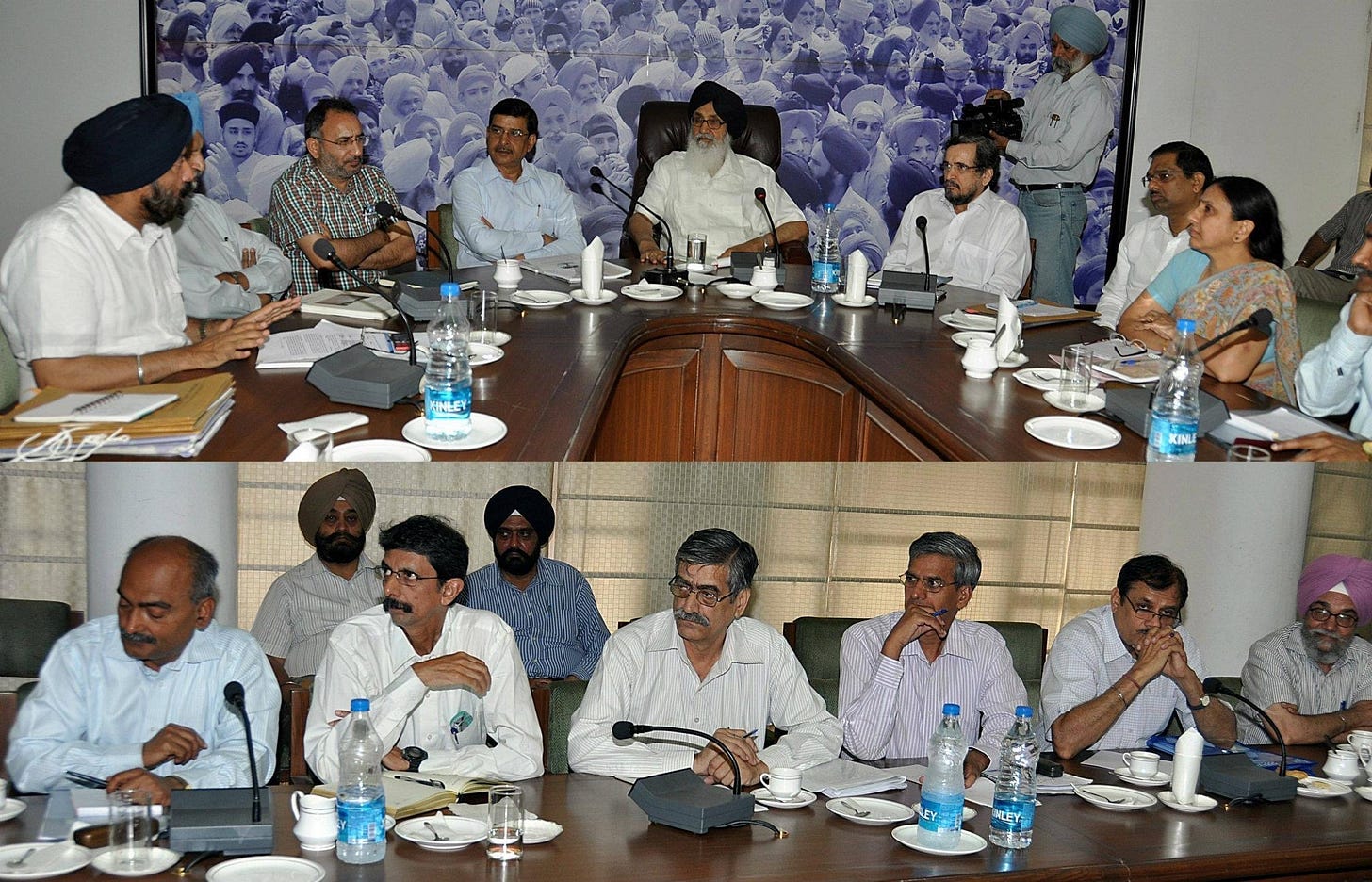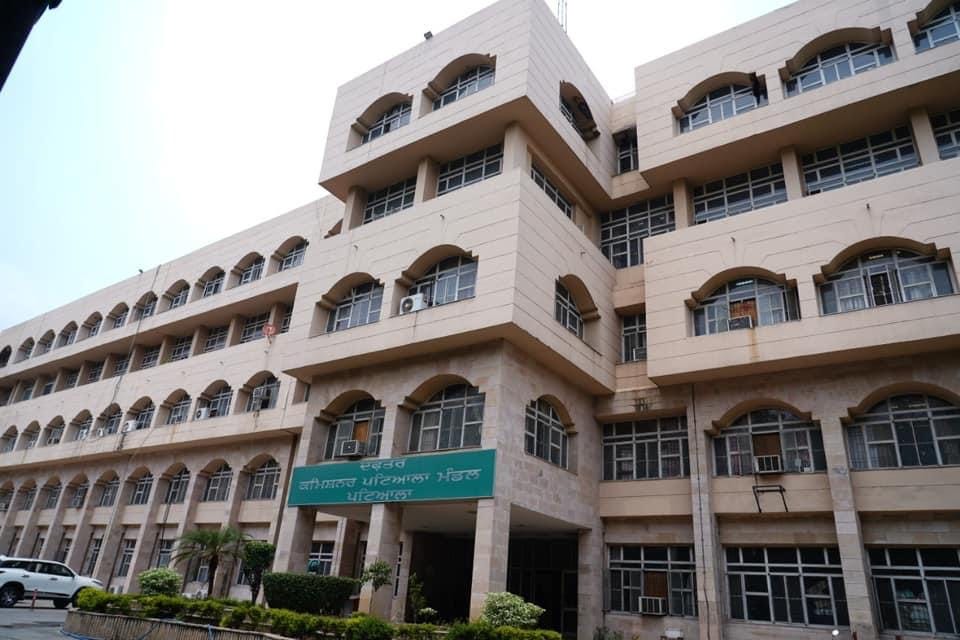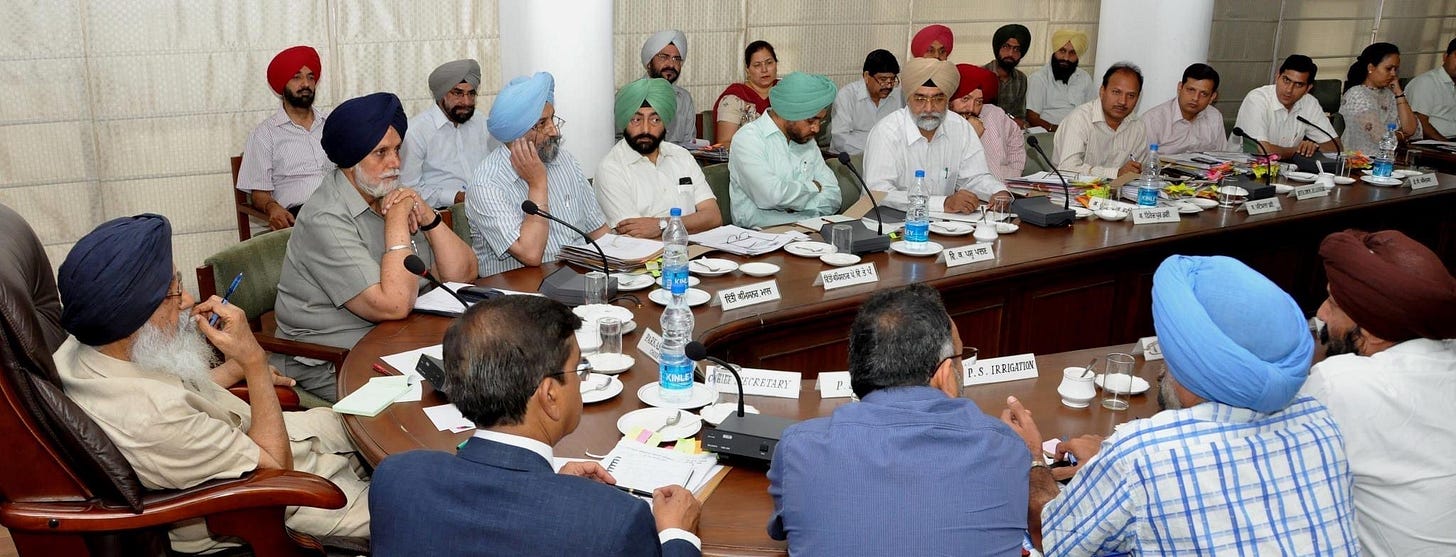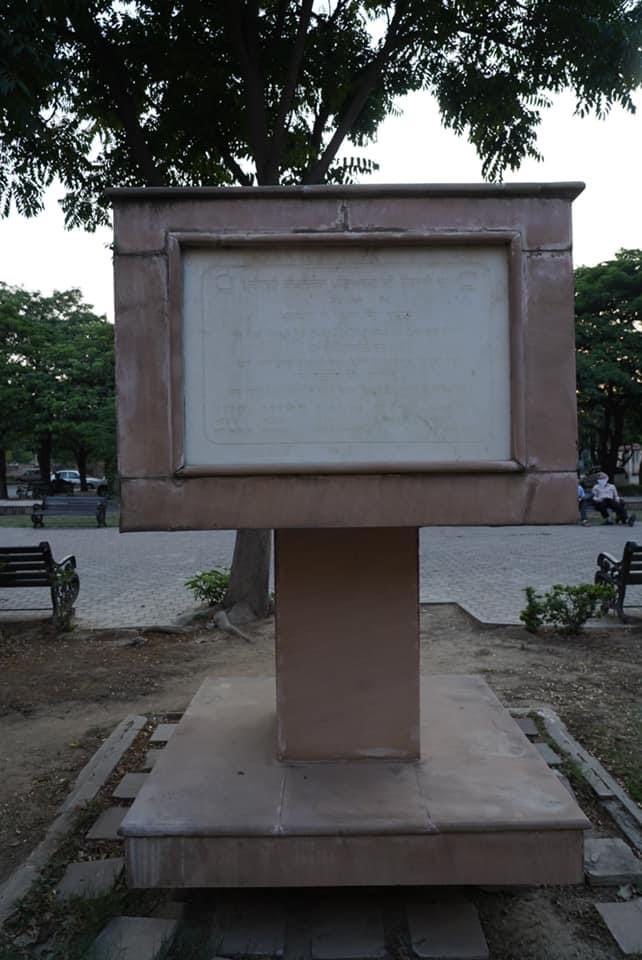My Journey with Parkash Singh Badal: Reflections on a Colossus
Remembering Parkash Singh Badal: A Tribute to the Visionary Leader and His Enduring Legacy in Indian Politics.
End of an Era: The political landscape of Punjab has been forever changed by the passing of Parkash Singh Badal, a man who dedicated his life to public service and the betterment of his state. As a five-time Chief Minister of Punjab, he spearheaded numerous development projects and initiatives that transformed the state. During my tenure as a Punjab cadre IAS officer, I had the honor of interacting with him on several occasions, and I can say that his leadership, vision, and commitment to public service were truly inspiring. In this piece that I just penned, I would like to pay my humble tribute to him by sharing my personal experiences and reflections on his life and legacy.
My induction into IAS: During the early years of my service in 1984, Punjab was under President's Rule. It wasn't until the Rajiv-Longowal accord in 1985 that Vidhan Sabha elections were held, and Surjit Singh Barnala became the Chief Minister. However, Mr. Badal's faction chose not to join the Ministry. Unfortunately, the Barnala Government was dismissed in 1987, and the State continued under President's Rule until 1992. In the February 1992 elections, Mr. Parkash Singh Badal's Shiromani Akali Dal boycotted the polls, and the Congress Government led by Sardar Beant Singh assumed office. As a result, I did not have the opportunity to interact with Mr. Badal during this period, either as a part of the Government or formally as an opposition leader.
Deputy Commissioner Amritsar: In 1994, while serving as Deputy Commissioner in Amritsar, I had the opportunity to supervise the conduct of a crucial by-election for the Ajnala Vidhan Sabha seat. This election was ordered due to the unfortunate passing of Harcharan Singh Ajnala, the Speaker of Vidhan Sabha. The Chief Election Commissioner at the time was the strict and uncompromising TN Seshan. Mr. Badal's Shiromani Akali Dal put up an official candidate, while the Beant Singh Government deployed its full might to maintain the prestige of the Congress Government. This by-election was seen as a true test of the people's pulse, as the previous 1992 elections were widely regarded as unrepresentative due to the miniscule poll percentage and the boycott by the mainstream Akali Dal. The stakes were high, and the outcome would have far-reaching implications for Punjab's political future.
Ajnala by-election: It was during the by-election for the Ajnala Vidhan Sabha seat that Mr. Badal requested a meeting with me, while he was camping at the Circuit House in Amritsar. This was my first face-to-face meeting with the legendary leader. Mr. Badal was understandably concerned about the possibility of election rigging, given the prevalent use of paper ballots at the time and his understandable lack of faith in the election machinery, including the police. He specifically wanted me to ensure that the election was conducted fairly and that the counting process was transparent. Although I assured him that the officials would remain neutral, Mr. Badal remained skeptical and even requested to be present inside the counting hall. I advised him against appointing himself as a counting agent, assuring him that the election would be free and fair. Despite his initial reluctance, he agreed. Mr. Badal's candidate emerged victorious with a thumping margin of over 10,000 votes, marking a turning point in his political fortunes. The next morning, he personally telephoned me to express his gratitude for the impeccable conduct of the election and offered his assistance if I ever needed it. The first phase of my interaction with him had ended on a positive note.
Transport Department: Following my successful tenure as DC Amritsar, I was sponsored for a one-year MA Economics course at the University of Manchester, UK by the Government of India. Upon my return in August 1997, the government led by Parkash Singh Badal, who had won the February 1997 elections, was already in power. After a brief stint as Labour Commissioner, I was appointed as Director State Transport, Punjab in 1998. Mr. Badal, who had extensive experience in the transport industry, assigned me the task of transforming the loss-making State Transport Undertaking (STU) into a profitable venture. I proposed a fare hike, the purchase of new buses, and the recruitment of additional drivers. Despite bureaucratic hurdles, I managed to execute the plan efficiently, with Mr. Badal's political clout helping to overcome obstacles where necessary. The result was a matter of record, as Punjab Roadways reported "cash profits" for the first time in many decades, in the year 1999-2000.
“Sangat Darshan” Scheme: In late 2000, I took on the role of the Chief Administrator, Punjab Urban Planning and Development Authority (PUDA), a single authority for housing and urban planning and also responsible for implementing the Optimal Utilisation of Vacant Government Lands Scheme (OUVGL) across the entire state of Punjab. Our team focused on identifying and developing unused or underutilized government properties for sale. The revenue generated from these sales was then used to build District Administrative Complexes in several cities, including Patiala, Bathinda, Sangrur, Jalandhar, Moga, Hoshiarpur, and PUDA's own iconic building in Sector 62 at SAS Nagar (Mohali). The funds also fueled Mr. Badal's innovation, the "Sangat Darshan" programs, which aimed to issue cheques for village-level projects like school and dispensary buildings on-the-spot, in the village assembly itself. Despite facing opposition from some detractors who raised frivolous objections, we successfully obtained all necessary approvals, and the "Sangat Darshan" programs continued as a popular feature of rural development, until the February 2002 elections.
Phulkian Enclave: During the foundation-stone laying ceremony of the District Administrative Complex (DAC) at Patiala, in early 2001, some individuals informed Mr. Badal that I had named the new urban residential development as "Phulkian Enclave" to indirectly benefit Captain Amarinder Singh, the Punjab Congress President, and the scion of the royal "Phulkian" family of Patiala, as the elections were approaching in February 2002. Mr. Badal asked me about it, and I explained that by giving it a regal name, people might be willing to pay higher prices for the plots, as opposed to an ordinary name, which would sell for 3600 rupees a square yard. Regardless, the funds generated from the sale of plots would be used to build the DAC at Patiala. Mr. Badal approved my decision, which showcased his ability to rise above petty politics and display statesmanship.
Education Department: During the period between 2002 to 2007, I had very few interactions with Mr. Badal as he was out of power, and was in Chandigarh mostly during the Vidhan Sabha sessions only. However, our paths crossed again when he returned to power in 2007 and appointed me as the Secretary of School Education. Working alongside the Education Minister, Dr. Upinderjit Kaur, herself a Ph. D. in economics, we were able to improve and rebuild village schools and streamline the recruitment process based on transparent and rational criteria. Our efforts led to the creation of the "Adarsh Schools Scheme" in the public-private-partnership (PPP) mode. Later, in 2009, I was also given the responsibility of Higher Education. Under Mr. Badal's guidance, we established degree colleges in educationally backward districts and implemented a transparent policy for private universities in the state. Mr. Badal's unwavering interest and support to the Education Department were instrumental in clearing any impediments that arose during the implementation of these initiatives.
Finance Portfolio: In 2010, Parkash Singh Badal appointed me as the Principal Secretary, Finance (PSF), while his nephew Manpreet Badal held the post of Finance Minister. As the PSF, I was responsible for balancing the state's demands for funds, while ensuring the fiscal and financial stability of Punjab. This was not an easy task as there was often a sharp difference in opinion between the Deputy CM, Sukhbir Badal and Manpreet Badal, who did not always see eye to eye. However, with Parkash Singh Badal's moderating influence, we managed to work together for a year. When Manpreet Badal resigned in 2011, I continued as the PSF, managing fund releases during the election year as deftly as I could. Some attributed Parkash Singh Badal's return to power in the 2012 elections to my pragmatic and positive approach as PSF. I thought I was just doing my job.
Shahpur Kandi Dam Project: Upon receiving my post in 2012 as Principal Secretary Irrigation, I had already expressed my interest in a central deputation. Nevertheless, during my 11-month tenure, we were able to successfully allocate the long-stalled Shahpur Kandi Dam Project, a national project on river Ravi, through transparent global tendering. The project was promptly initiated, thwarting Haryana's attempt to seek a Supreme Court injunction due to the pending River Waters Dispute. This project would conserve valuable water resources that would otherwise flow into Pakistan, in addition to generating electricity and irrigating additional areas in Punjab and J&K.
Return from Delhi as FCR: While I was in the third year of my 5-year tenure on Central deputation as Joint Secretary and Additional Secretary, Government of India, I received a call from Parkash Singh Badal in January 2016. He wanted me to return to my parent cadre of Punjab to serve as Financial Commissioner, Revenue (FCR) in Punjab. Despite the election year's chaos, I agreed to return to the state under his guidance. We distributed over Rs 600 crores to cotton farmers and labor affected by the American Bollworm crisis. Our successful efforts to save Punjab from the SYL Canal issue after the adverse Supreme Court judgment are perhaps a story for another day. However, I have shared valuable inside information on the matter in my YouTube video, of which I share link here.
During the February elections, in addition to my post as FCR, I was given the charge of Additional Chief Secretary Home by the Election Commission of India. Our team ensured a free and fair election. Although Mr. Badal’s Party had lost the elections, I visited him at his official residence after the results were out, and found him to be in his usual "chardi kala" state.
Post-2017 Badal Sahib: Certainly, the defeat of Akali Dal in the 2017 elections was a setback, but the rout of 2022 has somewhat eclipsed his legacy. It must, however, be noted that he was no longer formally the President of Shromani Akali Dal during these elections. After I superannuated from the IAS in July 2021, I visited him at his ancestral village Badal. We chatted for over half an hour, and I thanked him for all his support and patronage throughout my professional career. He was visibly touched by my gesture, and that was the last time I saw him, although we did talk on the phone on a few more occasions. The news of his demise this evening has left me reminiscing about my memories with him. He was truly a colossus and will be remembered for his immense contribution to the people of Punjab.
Obituary: The passing of Parkash Singh Badal is a great loss not only for the state of Punjab but for the entire country. He was a towering figure in Indian politics, who served as the Chief Minister of Punjab for a record five terms. His contributions to the state, especially in the areas of agriculture, education and infrastructure development, are exemplary. He was a true leader who worked tirelessly for the betterment of his people, and his legacy will continue to inspire generations to come. His death marks the end of an era in Punjab politics, and he will be deeply missed by all who knew him. Rest in Peace, Sardar Parkash Singh Badal.






Our batchmate Shri Davinder Kumar Garg sent the following message, after reading my article: ⬇️⬇️⬇️
End of an era 🙏🏼
I belong to a place (Sukhna Ablu) which falls in his traditional family constituency of Gidderbaha. We have seen him transform from a simple village man to a big politician & landlord in a few decades. He is the man who brought primary amenities of modern life including electricity, pucca roads, bus service etc to our village. I remember him as a pioneer who built a small library in our school and encouraged us to read books and newspapers.
He used to accompany Sant Fateh Singh often camping at night in our school. We have seen the first electric bulb glittering probably in 1974-75. The region of this part of Malwa (my ancestral place) was backward and it was due to his efforts that the region saw the first signs of progress in education, transport and infrastructure like industrial focal points, pucca khals and deep water pumps.
However, the things took a turn in the mid nineties onwards, where he started moving away from his roots.
Whatsoever, we the people of Sukhna- Doda-Kotbhai area will never forget his postive intervention.
May Almighty bless the departed soul. RIP 🙏🏼
A True Tribute to Badal Sahib